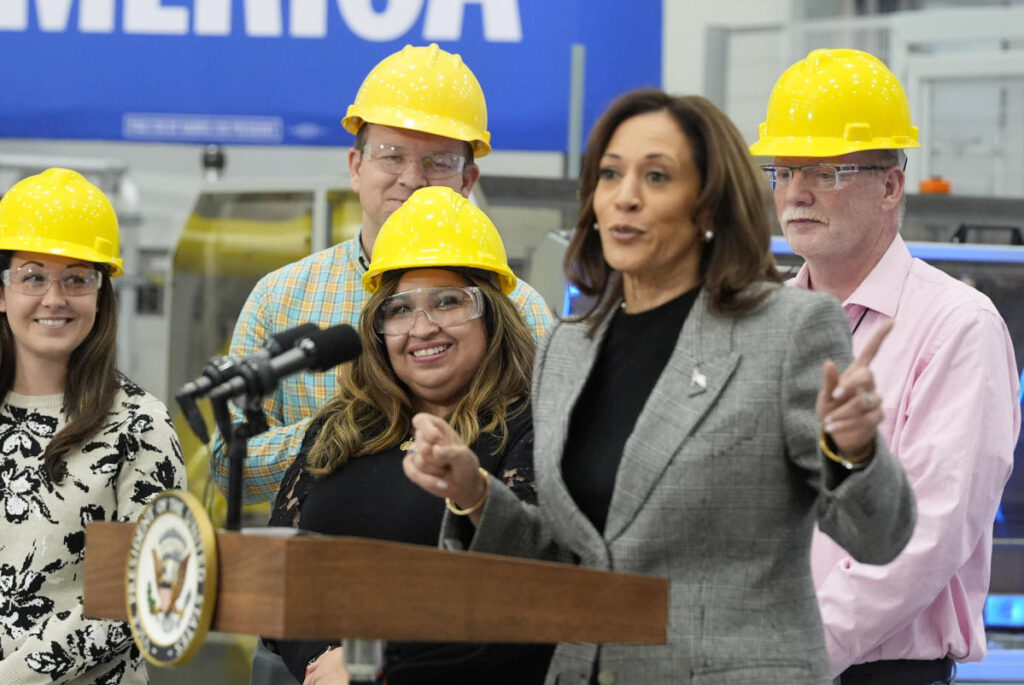Kamala Harris visited Saginaw County, Michigan, to emphasize the significance of government funding for computer chip manufacturers, presenting it as a crucial opportunity to create factory jobs in a state that plays a pivotal role in electoral politics. This visit came on the heels of Donald Trump’s criticism of the bipartisan CHIPS and Science Act, enacted in 2022, which allocates substantial resources to enhance U.S. semiconductor manufacturing capabilities. Harris highlighted a recent announcement by the Commerce Department that Hemlock Semiconductor would receive up to $325 million in direct support to establish a new factory dedicated to producing hyper-pure polysilicon. This investment is projected to generate 180 factory jobs in Michigan, underscoring the administration’s commitment to revitalizing American manufacturing through targeted financial support.
During her factory tour, Harris engaged with workers and acknowledged the critical role they play in advancing American technology leadership. She stressed the importance of not stagnating on historical achievements, urging constant adaptation and investment in future industries while also honoring traditional sectors that have contributed to the U.S. economy. By framing the workers’ efforts as a source of optimism, Harris sought to convey a message of hope and progress amidst political tensions, effectively reinforcing the administration’s narrative that proactive government involvement is essential for economic growth and job creation.
Beyond her focus on manufacturing, Harris utilized her visit to integrate various campaign messages tailored to different voter demographics as the election approaches. For example, she emphasized support for forgivable loans aimed at small businesses when addressing Black and Latino men and highlighted abortion rights at a rally in Houston alongside Beyoncé, targeting women voters. Underlying these outreach efforts is her assertion that Trump poses a fascistic threat to democracy, a message meant to galvanize support against his returning influence in politics. This multifaceted approach aims to resonate with diverse audiences while presenting the administration’s ongoing commitment to progressive policies.
The CHIPS and Science Act, as noted by the Commerce Department, has already facilitated over $30 billion in funding for semiconductor projects across 15 states, anticipated to create approximately 115,000 additional manufacturing and construction jobs. This federal investment aims to reposition the United States as a significant player in global semiconductor production, with a target of producing 30% of the world’s most advanced chips by expanding capabilities that were nearly non-existent at the start of the Biden-Harris administration. Amidst this optimism, Trump has criticized the initiative, attempting to reframe the narrative around investment in semiconductor manufacturing as a failure to benefit the American working class.
In a recent podcast appearance, Trump expressed skepticism about the effectiveness of the CHIPS funding initiative, arguing that it primarily aids wealthy companies without guaranteeing long-term, quality job creation. Instead, he proposed imposing high tariffs on imported computer chips as a means to incentivize U.S. manufacturing rather than investing public funds in private enterprises. However, economists have largely refuted this idea, explaining that increased tariffs would likely exacerbate inflation and elevate costs for consumers reliant on electronics and automated systems, including automobiles and home appliances. This reality stems from earlier market disruptions linked to the pandemic, when supply chain issues led to a significant chip shortage that impacted numerous sectors.
Furthering her Michigan tour, Harris plans to visit a union training facility in Macomb County and hold a rally in Ann Arbor, a city populated with a considerable number of college graduates who tend to lean Democratic. At the rally, she will campaign alongside her running mate, Minnesota Governor Tim Walz, and feature performances from artists like Maggie Rogers, aiming to draw an enthusiastic crowd. By interspersing concert elements within rallies, the campaign hopes to engage voters meaningfully while encouraging participation in the coming election, particularly through early voting. This strategy of merging entertainment with political mobilization seeks to tap into cultural resonance as a method to invigorate voter turnout and build a coalition for success leading into the election.

